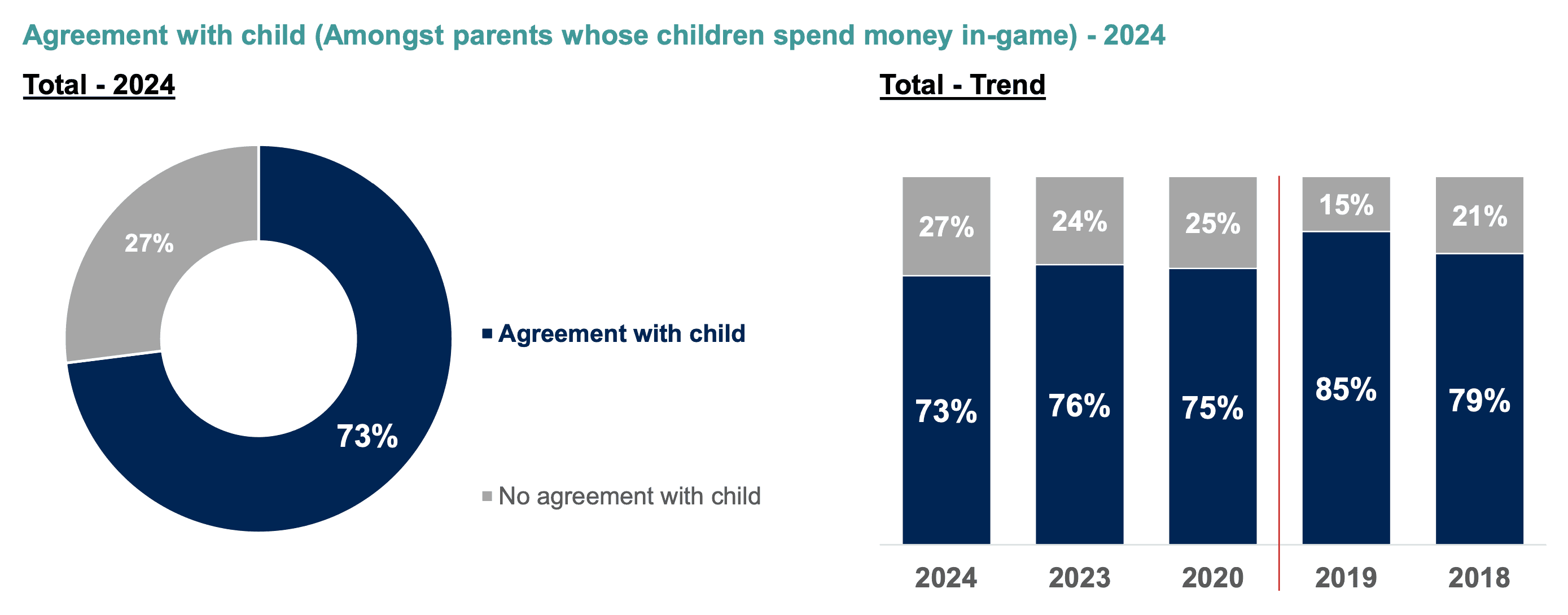
How Children Spend Money in Video Games
An Ipsos survey reveals trends in children's in-game spending in Europe, showing decreased parental spending and the popularity of gameplay-impacting items in 2024.
Ipsos, in collaboration with Video Games Europe, recently conducted a survey of 2,772 parents and guardians to examine the spending behaviors of children within video games. The survey focused on European households, providing insights into the types of in-game purchases made by children, parental spending habits, and awareness of gaming features like loot boxes. Findings suggest a shift in spending trends and highlight a cautious approach from parents toward monitoring and limiting their children’s in-game expenses.
Key Takeaways
The Ipsos survey provides an in-depth look at the current state of children’s in-game spending in Europe.
- Parental Spending Decrease: Average parental spending on children’s in-game purchases dropped from €39 to €31 per month.
- Dominant Purchase Categories: Gameplay-enhancing items, such as weapons and powers, remain the most popular category, followed by cosmetic items.
- Parental Monitoring Remains High: A majority of parents (95%) monitor their children’s in-game spending, with many establishing agreements to limit or approve purchases.
- Low Engagement with Loot Boxes: Only 4% of players engage with loot boxes, likely influenced by lack of awareness and ongoing regulatory concerns.

How Children Spend Money in Video Games
Children’s In-Game Spending
As of 2023, a significant majority of parents, about 76%, reported that their children do not engage in in-game spending. Among parents who indicated their children do make purchases, in-game items that impact gameplay, such as additional weapons or powers, emerged as the most popular category, with 38% of these parents identifying such purchases.

Child Spend In-Game 2024
Cosmetic items, which do not affect gameplay, are the second most popular category at 30%. In contrast, loot boxes—a form of purchase offering randomized rewards—are less common, with only 21% of parents reporting that their children buy them. This relatively low engagement with loot boxes may be due, in part, to regulatory scrutiny and limited parental awareness; the survey revealed that 71% of respondents were unaware of loot boxes and their function in games.

Items Spent Money On 2024
Decline in Parental Spending
One of the more notable findings from the study is a drop in parental spending on children’s in-game purchases. On average, parents now spend around €31 per month on these items, an €8 decrease from the previous year’s €39 per month. While the survey did not explore the reasons behind this decline, it may reflect broader economic conditions or a conscious effort among parents to control in-game spending.
Additionally, nearly three-quarters (73%) of respondents reported that their children’s monthly in-game spending falls within a modest range of €1 to €20. This data suggests that most parents are keeping a close watch on gaming expenses and setting limits on the amounts their children can spend.

Claimed Average Spend Per Child
Parental Monitoring and Agreements
According to the survey, parental monitoring of children’s in-game spending remains a high priority, with 95% of parents indicating they actively keep track of how their children spend money within games. Parental control in this area often includes explicit agreements with children, with 63% of parents who have children that spend on in-game extras reporting an established understanding or guidelines around spending.

Agreement with Child
The level of parental oversight includes asking for permission before making purchases (49%) or setting clear spending limits (27%). However, there has been a slight decline in the proportion of parents with formal agreements regarding in-game spending, dropping from 76% in 2023 to 73% in 2024. Despite this, the overall high percentage suggests that parental involvement and control remain central to managing children’s gaming expenditures.

Types of Agreement with Child
Limited Engagement with Boot Boxes
In addition to tracking children’s in-game spending, the survey also looked at players’ engagement with in-game currencies and loot boxes. Findings show that the majority of players do not frequently interact with these spending options. Only 11% of respondents aged 11 to 64 reported spending real money on in-game currencies, and a mere 4% acknowledged spending on loot boxes. These figures have remained stable year over year, indicating that these features have not seen a significant increase in popularity or acceptance.
The limited awareness and engagement with loot boxes among European gamers, especially among younger players, could be influenced by the ongoing scrutiny and discussion around the ethics of loot boxes. The randomized nature of loot boxes has led to concerns and regulatory actions in several countries, potentially affecting how widely they are used and promoted within games.

Awareness of Loot Boxes
Final Thoughts
The Ipsos and Video Games Europe study highlights a cautious approach by European parents regarding their children’s in-game spending, with a noticeable decrease in spending and high levels of oversight. The popularity of gameplay-impacting items suggests that these remain a draw for young players, while loot boxes, under greater scrutiny, remain relatively unpopular. Parental monitoring and established agreements appear to be effective methods for managing gaming expenses, reflecting a wider awareness of the potential risks associated with in-game spending.
About the author
Eliza Crichton-Stuart
Head of Operations
Updated:
November 5th 2024
Posted:
November 5th 2024


